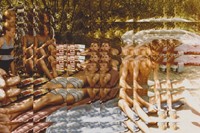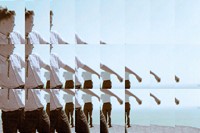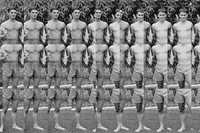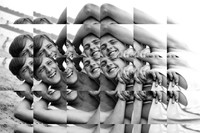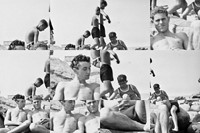Edouard Taufenbach’s latest exhibition, Suddenly, Last Summer, is a collection of collages, the original photographs for which come from filmmaker Sébastien Lifshitz’s extensive archive of LGBTQ+ found imagery
The 2012 documentary Les Invisibles told the stories of 11 French men and women, all of whom are over the age of 70 and identify as gay. Director Sébastien Lifshitz felt compelled to document the lesser-seen lives of this demographic of the LGBTQ+ community after discovering some photographs – the filmmaker collects amateur found photography, and has built a 10,000-strong archive of queer imagery – of an older lesbian couple. Lifshitz’s photography collection has been exhibited around the world, at institutions including Les Rencontre d’Arles, Le Centre Pompidou in Paris and The Photographers’ Gallery in London, and it was a book of his Les Invisibles project which caught the attention of collage artist Edouard Taufenbach. Suddenly, Last Summer is a recently opened online exhibition at Elizabeth Houston Gallery, bringing together collages by Taufenbach, the original imagery for which is from Lifshitz’s archive.
The exhibition has opened to coincide with Pride month, celebrated this year with virtual events due to the Covid-19 pandemic. Taufenbach’s joyful images – the original photographs range in date from the 1940s to the 1980s – depict “leisure and pleasure” within the LGBTQ+ community of decades past. In his collage practice, Taufenbach stretches and distorts photography by inserting new panels and squares, each a slightly different repetition of the image’s detail. The result is collages which seem to pulse with movement, with figures moving across beaches in the sun-drenched scenes; the viewer is left to imagine the lives of these anonymous protagonists. Taufenbach is a lover of cinema – he studied filmmaking before art, and has worked with found footage – and there are many stories to be uncovered in his collages. With titles like Marlon and Belle de Jour, his work recalls the glamour of 20th-century cinema. Here, Taufenbach explains Suddenly, Last Summer and his collaboration with Lifshitz in his own words.
“The title is a very good way to present the exhibition: Suddenly, Last Summer. I like it very much because it refers to something from the past and paradoxically to something immediate, present. It’s all the work I tried to do on the images of Sebastien Lifshitz’s collection. Using anonymous photographs from the 1940s to the 1980s and bringing a new life and movement into them, bringing them back to the present through the montage – cutting the images and making a collage out of them. Somehow it’s a bit like making cinema, making your own cinema with photographs, and telling stories.
“Sébastien has been benevolent and also demanding when selecting together his images. Soon we imagined a game whereby we would meet in a café once a week where he would bring 100 of his anonymous photographs out of which I had to select only 10. Depending on my choices the following week he would come back with another 100 photographs. After a few months we had a kind of common language: he understood what I was looking for in his photographs and he taught me how to look into the pictures and to know exactly how to find what I was looking for inside them.
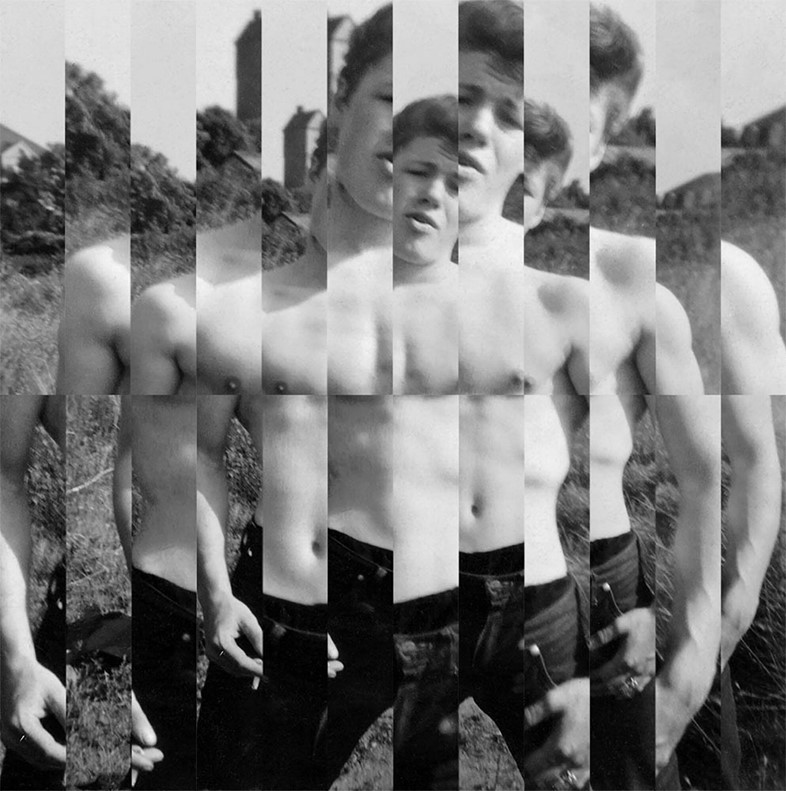
“Sébastien’s collection is a set of rare images and it is extraordinary to think how courageous all the characters were that took these pictures back in the days. They probably had to go to a third party to print these pictures, going to a photography shop to collect photographs of situations that did not correspond to the model of life expected by society at the time required courage, strength to break free from norms. I like the idea that my work pays tribute to these courageous people who are genuine examples, and entices younger generations to stand for who they really are.
“The images in Sébastien’s collection are chosen with care. My selection criteria is several folds: they should be inhabited by a graceful form and elegance. I also love to select strong images that bear a kind of fragility in the characters they depict. For example, the collage Marlon is made from a picture that shows a very handsome young man posing bare-chested, inflating his muscles with a cigarette in his hand (all the expected attributes of masculinity). I worked on this image by playing with two different scales in order to unfold these contracted muscles, like a small Hulk ... the result makes him appear to move, as if he wants to become stronger than he was. As opposed to making him stronger, it makes him more fragile and reveals his aspirations to become an icon of masculinity.
“The sound of the wind in the moving branches, the sound of the sea, the warmth of the sun on the skin, the smell of the grass, the feeling of caressing skin against skin … That is what unites all the photographs chosen for my project. It is all about softness and sensations. Through my work, I tried to foster these sensations and impressions and to bring back memories of their own sensations to the people that look at and into my collages.”
Suddenly, Last Summer is at Elizabeth Houston Gallery until July 31, 2020.

